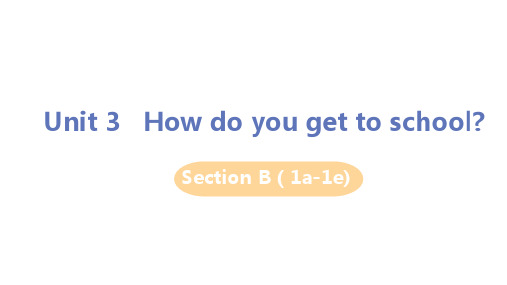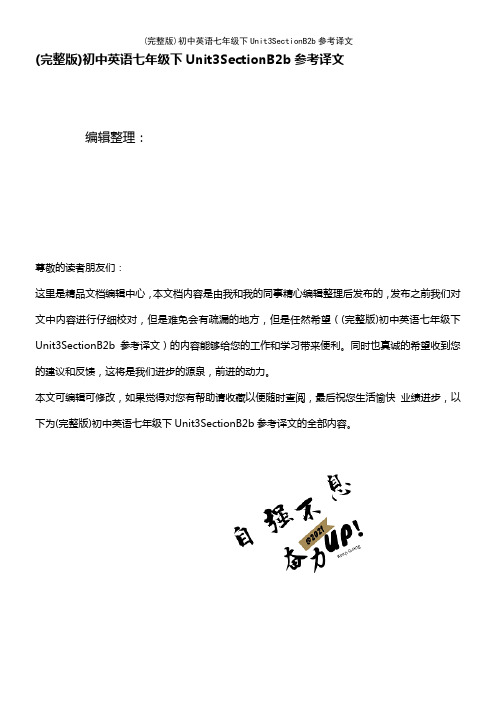(word完整版)人教版初中英语七年级下册Unit3SectionB教材全解
- 格式:doc
- 大小:101.51 KB
- 文档页数:9




Unit 3 How do you get to school?Section B (2a-2c)教学设计古浪六中徐月娟Unit 3 How do you get to school?Section B (2a-2c)Teaching Aims1.Knowledge and abilitiesMaster the new words and phrases.Practice students’ reading and understandingabilities.2.Processes and methodsLearn the new words and read the passageGroup-work ; Pair-work3.Emotional attitude and valueLove our life and love to help others.Teaching key points1.Learn the new words.2.Reading and understanding.Teaching difficult pointsImprove students’ reading ability.Teaching aidsA tape records , screenTeaching proceduresStep 1 Warming upInvite students to make conversations about talking how we get to school.A:“How do you get to school ?”B: “I get to school by bus.”……Step 2 New words1.Teacher show the new words ,and invite some studentsto read out the words one by one .2.Students repeat ,and the teacher correct thepronunciation.3.Let students make sentences using each word.4. Read the new words for several times to master thewords.Step 3 Before-readingThe teacher show the picture and the title ,let students guess what the passage is about.Students may give the answers as below:How do the students go to school ?Why do they go to school like the picture?What is the students’ dream?Step 4 While- readingFirst ,Scan the article .1.Make students understand they should read and answerthe following questions①How do the students in the village go to school?②Why do they go to school like this?③Does the boy like his school ? why?④What is the villagers’ dream ? Do you think their dream can come true? Why or why not?2.The teacher play the tape ,and students listen carefully ,at the same time students pay attention to the pronuciation and underline the answers to the questions.3.Invite some students to check the answers in pairs.One ask and the other answer.Second , understand the passage .1.Students read the passage together .2.Choose some key and difficult sentences to explain.Make sure that students really understand.Third ,finish acivity 2c.1.The students cover the passage and fill in theblanks with the words from the passage accordingto the memory.2.Check the answers.Step 5 After-reading1.Recite the story.①The teacher let students recite the storyusing the main words and sentences in thepassage .②Invite some to recite in class.2.Expand .Role-play the conversation .Student A is an interviewer from CCTV, studentB is the boy in the passage . Talk about how heget to school according to the story. If the timeis enough we can practice the conversation inclass. If there is not enough time topractice ,students can finish it after class andact it in class next class.Step6 SummarySummarize the lesson by reciting the story. Step 7 Homework1.Recite the story. Write the story according to thepassage.2.Role-play the conversation.3.Write the conversation and practice.Step 8 Blackboard。

(完整版)初中英语七年级下Unit3SectionB2b参考译文编辑整理:尊敬的读者朋友们:这里是精品文档编辑中心,本文档内容是由我和我的同事精心编辑整理后发布的,发布之前我们对文中内容进行仔细校对,但是难免会有疏漏的地方,但是任然希望((完整版)初中英语七年级下Unit3SectionB2b参考译文)的内容能够给您的工作和学习带来便利。
同时也真诚的希望收到您的建议和反馈,这将是我们进步的源泉,前进的动力。
本文可编辑可修改,如果觉得对您有帮助请收藏以便随时查阅,最后祝您生活愉快业绩进步,以下为(完整版)初中英语七年级下Unit3SectionB2b参考译文的全部内容。
(完整版)初中英语七年级下Unit3SectionB2b参考译文编辑整理:张嬗雒老师尊敬的读者朋友们:这里是精品文档编辑中心,本文档内容是由我和我的同事精心编辑整理后发布到文库,发布之前我们对文中内容进行仔细校对,但是难免会有疏漏的地方,但是我们任然希望(完整版)初中英语七年级下Unit3SectionB2b参考译文这篇文档能够给您的工作和学习带来便利.同时我们也真诚的希望收到您的建议和反馈到下面的留言区,这将是我们进步的源泉,前进的动力.本文可编辑可修改,如果觉得对您有帮助请下载收藏以便随时查阅,最后祝您生活愉快业绩进步,以下为 <(完整版)初中英语七年级下Unit3SectionB2b参考译文〉这篇文档的全部内容。
初中英语七年级下 Unit 3 Section B 2b 参考译文Do You Think You Will Have Your Own Robots?你认为你将拥有自己的机器人吗?1。
When we watch movies about the future, we sometimes see robots。
They are usually like human servants。
They help with the housework and do jobs like working in dirty or dangerous places。

- 1 - 人教版初中英语七年级下册Unit3SectionB教材全解 Unit 3 How do you get to school?
Unit 3 Section B教材全解 1.bus stop 公共汽车站 【重点注释】stop,此处用作名词,意为“车站;站点”。例如:at a/the bus stop在公共汽车站。stop一般指的是小站,停车点,如路边的停车站点;station指的是总站,大型的车站,at a bus/train/subway station。例如:They wait for Jim at the bus stop.他们在公共汽车站等吉姆。Where si the bus station?公共汽车站在哪儿? 【辨析记忆】bus stop与bus station bus stop与bus station都是指“公共汽产站”。 bus stop指城镇内外的停车点,而bus station指能听、转车辆的汽车站点。 【拓展记忆】stop用作动词,意为“停止”。常用结构: stop to do sth. 停止或中断(原来)做(的)某事,再去做另一件事。停下来去做某事。 stop doing sth. 停止(正在)做(的)某事。停止做某事。 例句:Let’s stop to have a rest.让我们停下来(原来干的事),(再去)休息一下吧。Stop talking,please.请停止(正在)说话(这个事)。They stop to smoke a cigarette.他们停下来(原来干的事),(然后)抽了根烟。I must stop smoking.我必须戒烟了(我必须停止正在抽烟这个事)。 2.Mary wants to know where Bob lives.玛丽想知道鲍勃住在哪儿。 Mary wants to know what he thinks of the trip. 玛丽想知道他(鲍勃)认为这段旅程怎么样。 【重点注释】①Mary wants to know where Bob lives.玛丽想知道鲍勃住在哪儿。本句含有一个由连接词where引导的宾语从句。在复合句中用作宾语的从句叫宾语从句。无论主句是陈述句还是疑问句,宾语从句都必须使用陈述语序,即“主句+连词+宾语从句(主语+谓语+……)”句式。如果主句的谓语动词是一般现在时,从句的谓语动词可根据需要,选用相应的任何时态。例如:Please tell me who knows the answer.请告诉我谁知道答案。Do you know which class he is in?你知道他在哪个班级吗?I don’t know when he will come back.我不知道他将何时回来。【试题链接】I don’t know . A.where she comes from Bhow old is he C.when was he born (宾语从句要用陈述语序,选项B、C都是疑问语序。根据句意“我不知道他来自哪里。”可知答案为A。) ②Mary wants to know what he thinks of the trip.玛丽想知道他(鲍勃)认为这段旅程怎么样。这是一个含有what引导的宾语从句的主从复合句,主句的主语是Mary,谓语动词时wants to know,宾语时一个特殊疑问句,原句应为“What does he think of the trip?”,但在宾语从句中,从句的语序要用陈述语序,其中疑问词仍在句首,位置不变;另外,宾语从句的时态与主句的时态要一致。例如:I know where you live.我知道你住在哪儿。Thomas wants to know how she gets to school.托马斯想知道她该怎样到学校。Do you know what he weather is like today?你知道今天的天气怎样吗? ③think of意为“认为,想出,想到,考虑”,of 是介词,其后可接名词、代词 - 2 -
或V.ing形式,think of/about doing sth.意为“考虑干某事”,在表示“认为……怎么样?”时,可以与think about互换。例如:——What do you think of /about how she gets to school?你认为这次学校郊游怎么样? ——It’s great.非常好。 【比较记忆】(1)think of与think about这两个短语表示下列意义时,可以互换:①考虑 eg: Don't think of/about me any more.不要再考虑我. ②对……有某种看法 eg: What do you think of/ about the film 你认为那部影片怎么样?(2)think of表示下列意义时,一般不和think about换用. ①想要;打算 eg: For a moment I thought of playing truant.我一时起了逃学的念头. ②想出;想到 eg: Who thought of the idea 谁想出的那个主意 ③关心;想看 eg: Lei Feng always thought of how he could do more for the people. 雷锋总是想着怎样多为人民做些事情. ④想起;说得 eg: I can't think of his name.我想不起他的名字. (3)think about表示下列意义时一般不和think of换用. ①"回想"过去的事情. eg: We mustn't think about this matter any more.我们不许再想此事. ②"考虑"某事,某计划是否切实可行. eg: I'll think about your suggestion and give you an answer tomorrow. 我要考虑一下你的建议,明天给你答复. 【拓展记忆】What do you think of the school trip?你认为这次学校郊游怎么样?What do you think of…?意为“你认为/觉得……怎么样?”,可与How do you like…?进行转换,这是用来询问某人对某事或某人的看法的常用句型。例如:What do you think of/about action movies.=How do you like action movies.你认为动作片怎么样? 课本1c的另外三句话:主句是?宾语从句是?宾语从句的连接词是?语序是? Mary wants to know how far he lives from his grandparents’home. 玛丽想知道他住的地方离他祖父母家有多远。 Mary wants to know how he gets to his grandparents’home. 玛丽想知道他是怎样到他祖父母家的。 Mary wants to know how long it takes to get to his grandparents’home 玛丽想知道到他祖父母家需要多长时间。 【归纳记忆】宾语从句要记住三个要素:①选用合适的连接词;②宾语从句用陈述句语序;③一般主从句时态一致。 3.Crossing the River to School.过河去上学。 【重点注释】①cross作动词,意为“横越;越过;穿过”,主要表示在物体表面上“横穿”,如横过马路(cross the road)、过桥(cross the bridge)、过河(cross the river)等。此处加上ing变成了动名词。例如:The little boy can’t cross the street by himself.这个小男孩不能独自过马路。Be carefull when you cross the street.过马路时要小心。They crossed the river by boat.他们乘舟渡河。②cross作名词,意为“十字形,叉形记号”。例如:The teacher marked the question with a cross.老师在这个问题上打了一个叉。 【比较记忆】cross,across与crossing sross 动词 穿过 Let’s cross the road now.现在咱们过马路吧。
across 介词,副词 在……对面,穿过 They live just across the road.他们就住在马路对面
crossing 名词 十字路口 Turn left at the first crossing.第一个十字路口左拐
注意:across是介词,有“横跨,横穿,穿越”之意。across与go/walk等动词连用表示“穿过,越过,横穿”的意思,go/walk/run/swim across…=cross(v.)…。与cross基本同义,也是表示从物体表面经过。例如:The Great Green Wall is across - 3 -
the northwest of China.绿色长城横跨中国西北。We can go across the freeze river. 我们可以横过这冻结了的大河。I swam across the Changjiang River 20 years ago. 20年前我横渡了长江。Look left and right before you go across the street. 过马路时要左右看。 【辨析记忆】across与through的区别:都是介词,在句中不能独立作谓语,必须和动词一起构成谓语。 across “横过,穿过“,着重指从一条线或一物体表面的一边到另一边,含义与on有关。
through “穿过,从……中通过”,着重指从空间的一头纵穿到另一头,含义与in有关。
辨析:across指从某一物体表面的一边到另一边,为“横穿”,与“道路”交叉形成“十字”。 go/walk/run/swim across…=cross(v.)…。而through指从某一物体的中间穿过,为在立体空间中的“穿过”。常用于穿过沙漠、森林、门窗、村庄等,如:go through the forest“穿过森林” (从森林中间通过),go through the tunnel“穿过隧道”(从隧道中间通过)go across the street “穿过大街” (从马路一边到另一边) 4.For many students,it is easy to get to school.对许多学生来说,到达学校是容易的。But for the students in one small village in China,it is difficult.但是对于在中国的一个小村庄里的学生来说,是困难的。 【重点注释】①for介词,在此意为“对……而言”。例如:It is difficult for me to finish my homework.对我来说,完成作业太难了。It’s time for me to get up.我该起床了。 ②many形容词,意为“许多”,后跟可数名词复数形式。例如:I have many books.我有许多书。There are many students in the classroom.教室里有很多学生。 【拓展记忆】①“many a +可数名词单数”谓语动词用第三人称单数形式。例如:Many a worker often comest to our school.许多工人经常来我们学校。②much也表示“许多”,但它修饰不可数名词。例如:There is much water in the glass.玻璃杯里有许多水。③many/much=lots of/a lot of.例如:He has many/a lot of/lots of beaubiful stamps.他有许多美丽的邮票。There is much/a lot of/lots of water here.这里有许多水。 ③课本原句For many students,it is easy to get to school.=It is easy for many students to get to school.对许多学生来说,到达学校是容易的。课本原句But for the students in one small village in China,it is difficult.= But for the students in one small village in China,it is difficult to get to school.= But it is difficult for the students in one small village in China to get to school. 但是对于在中国的一个小村庄里的学生来说,(到达学校)是困难的。 It is +形容词+(for sb.)+to do sth.句型意为“(对某人来说)做某事是……。”其中,代词it是形式主语,没有实际意义;动词不定式to do sth.是真正的主语。动词不定式或动词不定式短语作主语时,可直接放在句首。在英语中,当动词不定式短语较长时,为了避免头重脚轻,常把动词不定式短语作主语的情况放在后面,用it作形式主语。例如:To learn English well is not hard.学好英语不是很难。It is easy to ride a bike.骑自行车是容易的。It’s better to stay at home.呆在家里更好。It’s easy for him to do the exercise.他做这个练习很容易。 5.There is a very big river between their school and the village.在他们的学校和村庄之间有一条很大的河。 【重点注释】between介词,意为“在……之间;介于……之间”,指在两者(注意理解“两者”的含义)之间。在英语句子中,between可以单独用,也可以和